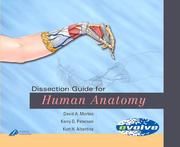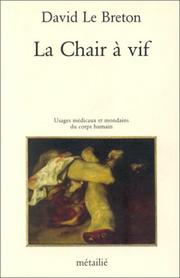| Listing 1 - 10 of 18 | << page >> |
Sort by
|
Book
ISBN: 9535128965 9535128957 9535173340 Year: 2017 Publisher: Rijeka, Croatia : IntechOpen,
Abstract | Keywords | Export | Availability | Bookmark
 Loading...
Loading...Choose an application
- Reference Manager
- EndNote
- RefWorks (Direct export to RefWorks)
This book contains a total of 21 chapters, each of which was written by experts in the corresponding field. The objective of this book is to provide a comprehensive and updated overview of cellular and molecular mechanisms underlying hypoxia's impacts on human health, as well as current advances and future directions in the detection, recognition, and management of hypoxia-related disorders. This collection of articles provides a clear update in the area of hypoxia research for biomedical researchers, medical students, nurse practitioners, and practicing clinicians in the fields of high altitude biology, cardiovascular biology and medicine, tumor oncology, obstetrics, pediatrics, and orthodontics and for others who may be interested in hypoxia.
Human dissection. --- Anatomy, Practical --- Practical anatomy --- Dissection --- Medicine --- Pulmonology --- Internal Medicine --- Health Sciences --- Anoxemia. --- Cerebral anoxia.
Book
ISBN: 0198571143 0198571135 9780198571148 Year: 1979 Publisher: Oxford: Clarendon,
Abstract | Keywords | Export | Availability | Bookmark
 Loading...
Loading...Choose an application
- Reference Manager
- EndNote
- RefWorks (Direct export to RefWorks)
Morphology --- Vertebrates --- Animals. --- Anatomy. --- Anatomy of animals(Practical) --- Vertebrate anatomy(Practical)
Book
ISBN: 0316802107 Year: 1978 Publisher: Boston Little, Brown
Abstract | Keywords | Export | Availability | Bookmark
 Loading...
Loading...Choose an application
- Reference Manager
- EndNote
- RefWorks (Direct export to RefWorks)
Human dissection --- Anatomy --- Dissection --- Anatomies --- Anatomy, Practical --- Practical anatomy --- methods --- Human anatomy

ISBN: 0443066272 9780443066276 Year: 2004 Publisher: Philadelphia (Pa.): Churchill Livingstone
Abstract | Keywords | Export | Availability | Bookmark
 Loading...
Loading...Choose an application
- Reference Manager
- EndNote
- RefWorks (Direct export to RefWorks)
Anatomy --- Dissection --- methods --- 612-089 --- Human dissection --- Anatomy, Practical --- Practical anatomy --- Biomedical methods. Surgical techniques. Dissection --- 612-089 Biomedical methods. Surgical techniques. Dissection --- Anatomy - methods --- Dissection - methods
Book
ISBN: 9780786444298 Year: 2012 Publisher: Jefferson McFarland
Abstract | Keywords | Export | Availability | Bookmark
 Loading...
Loading...Choose an application
- Reference Manager
- EndNote
- RefWorks (Direct export to RefWorks)
"This volume traces the past and present of public dissection. From Italian anatomy theaters to American dissecting laboratories, it chronicles the attacks on anatomy in the Middle Ages, the influence of Renaissance anatomist Andreas Vesalius, the procurement of bodies through execution and body snatchers, and the withdrawal of dissectors behind medical school doors in the early 20th century"--
Human dissection --- Dissection --- Anatomy --- Cadaver. --- Recreation --- Human dissection. --- Leiche --- Dissektion --- History. --- history. --- Europe. --- United States. --- Europa --- USA --- Leiche. --- Dissektion. --- Europa. --- USA. --- Anatomy, Practical --- Practical anatomy --- History
Book
ISBN: 9781421401423 1421401428 1421428164 1421429152 Year: 2011 Publisher: Johns Hopkins University Press
Abstract | Keywords | Export | Availability | Bookmark
 Loading...
Loading...Choose an application
- Reference Manager
- EndNote
- RefWorks (Direct export to RefWorks)
Of enduring historical and contemporary interest, the anatomy theater is where students of the human body learn to isolate structures in decaying remains, scrutinize their parts, and assess their importance. Taking a new look at the history of anatomy, Cynthia Klestinec places public dissections alongside private ones to show how the anatomical theater was both a space of philosophical learning, which contributed to a deeper scientific analysis of the body, and a place where students learned to behave, not with ghoulish curiosity, but rather in a civil manner toward their teachers, their peers, and the corpse. Klestinec argues that the drama of public dissection in the Renaissance (which on occasion included musical accompaniment) served as a ploy to attract students to anatomical study by way of anatomy’s philosophical dimensions rather than its empirical offerings. While these venues have been the focus of much scholarship, the private traditions of anatomy comprise a neglected and crucial element of anatomical inquiry. Klestinec shows that in public anatomies, amid an increasingly diverse audience—including students and professors, fishmongers and shoemakers—anatomists emphasized the conceptual framework of natural philosophy, whereas private lessons afforded novel visual experiences where students learned about dissection, observed anatomical particulars, considered surgical interventions, and eventually speculated on the mechanical properties of physiological functions. Theaters of Anatomy focuses on the post-Vesalian era, the often-overlooked period in the history of anatomy after the famed Andreas Vesalius left the University of Padua. Drawing on the letters and testimony of Padua's medical students, Klestinec charts a new history of anatomy in the Renaissance, one that characterizes the role of the anatomy theater and reconsiders the pedagogical debates and educational structure behind human dissection.
Human dissection --- Anatomy --- Dissection --- History, 16th Century --- History, 17th Century --- History --- history --- education --- Anatomy, Practical --- Practical anatomy --- Education --- Animal anatomy --- Animals --- Biology --- Physiology --- Surgery --- History of medicine
Book
ISBN: 9780922233342 0922233349 Year: 2009 Publisher: New York Blast
Abstract | Keywords | Export | Availability | Bookmark
 Loading...
Loading...Choose an application
- Reference Manager
- EndNote
- RefWorks (Direct export to RefWorks)
Human dissection --- Dissection --- Human body --- Photography --- Portrait photography --- Dissection du corps humain --- Corps humain --- Photographie --- Portraits (Photographie) --- History --- Histoire --- Anatomy, Practical --- Practical anatomy
Book
ISBN: 1800102224 1648250130 Year: 2021 Publisher: Rochester : University of Rochester Press,
Abstract | Keywords | Export | Availability | Bookmark
 Loading...
Loading...Choose an application
- Reference Manager
- EndNote
- RefWorks (Direct export to RefWorks)
Incorporates etymology, history, art, drawing, and reflective writing to support medical students in the integration of the science and humanity of anatomy.
Human dissection. --- Anatomy, Practical --- Practical anatomy --- Dissection --- Anatomy. --- Art. --- Biopsychosocial Approach. --- Etymology. --- Humanity. --- Medical Humanities. --- Medical Students. --- Medicine. --- Patient Care. --- Reflection. --- Science. --- Visual Learning.

ISBN: 2864241579 9782864241577 Year: 1993 Publisher: Paris: Métailié,
Abstract | Keywords | Export | Availability | Bookmark
 Loading...
Loading...Choose an application
- Reference Manager
- EndNote
- RefWorks (Direct export to RefWorks)
La leçon d’anatomie autrefois, le prélèvement d’organes aujourd’hui provoquent l’horreur des proches ou hantent les dernières heures de l’existence. Un sentiment de violation suscite la culpabilité de n’avoir pu empêcher la mutilation du corps de la personne aimée. Le greffé lui-même n’est pas indemne de troubles personnels après la transplantation. Le "don" qu’il reçoit est subtilement empoisonné d’exquise ou de cruelle façon.Le corps établit la frontière de l’identité personnelle ; brouiller cet ordre symbolique qui fixe la position précise de chaque individu dans le lien social, revient à effacer les limites identitaires du dehors et du dedans, du moi et de l’autre. Les limites du corps dessinent à leur échelle l’ordre moral et signifiant du monde. Un trouble introduit dans la configuration du corps est un trouble introduit dans la cohérence du monde. Ce champ de forces où s’opposent des valeurs que l’histoire n’a jamais réconciliées, est ici abordé sous l’angle de l’anthropologie, c’est-à-dire en s’efforçant de comprendre l’homme en tant qu’homme, acteur social, producteur de significations et de valeurs, inventeur de son univers propre dans la pluralité du monde possible.
Human dissection --- Body image. --- Psychological aspects. --- Body Image. --- Body image --- Anatomy, Practical --- Practical anatomy --- Dissection --- Image, Body --- Imagery (Psychology) --- Mind and body --- Person schemas --- Personality --- Self-perception --- Human body --- Psychological aspects --- Human dissection - Psychological aspects. --- Body Image
Book
ISBN: 0710209193 Year: 1987 Publisher: London Routledge and Kegan Paul
Abstract | Keywords | Export | Availability | Bookmark
 Loading...
Loading...Choose an application
- Reference Manager
- EndNote
- RefWorks (Direct export to RefWorks)
Death. --- Funeral Rites --- Social Conditions --- Body snatching --- -Dead bodies (Law) --- -Human dissection --- -Anatomy, Practical --- Practical anatomy --- Dissection --- Dead --- Law --- Theft --- Cardiac Death --- Determination of Death --- Near-Death Experience --- Death, Cardiac --- Thanatology --- Fatal Outcome --- history. --- Law and legislation --- Great Britain. --- Great Britain --- Isle of Man --- United Kingdom --- Social conditions --- -Body snatching --- Dead bodies (Law) --- Funeral rites and ceremonies --- Human dissection --- United Kingdom. --- -Death. --- -history. --- Death --- Anatomy, Practical --- Funerals --- Mortuary ceremonies --- Obsequies --- Manners and customs --- Rites and ceremonies --- Burial --- Cremation --- Mourning customs --- history --- Cryomation --- End Of Life --- End-Of-Life
| Listing 1 - 10 of 18 | << page >> |
Sort by
|

 Search
Search Feedback
Feedback About UniCat
About UniCat  Help
Help News
News